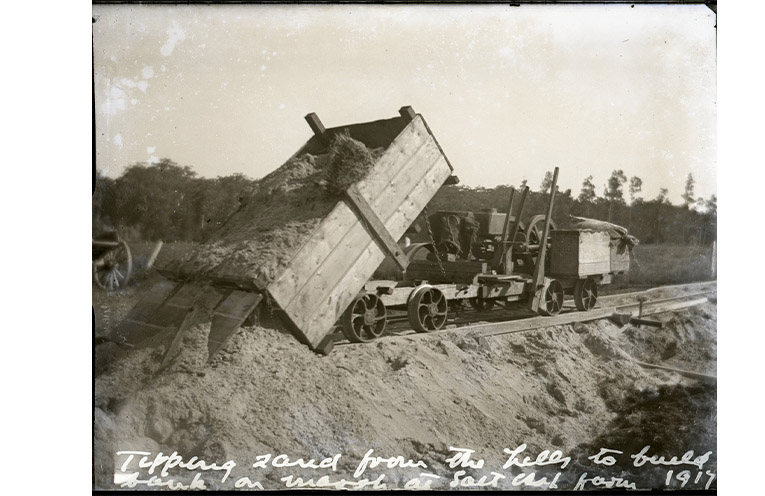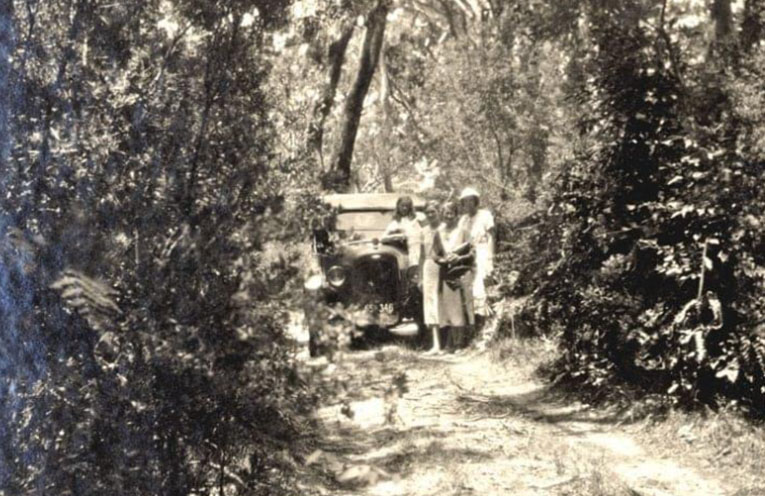MARSH Road has displayed a real character over the years that makes it unique.
I chose to write about the road in my latest book because, in my opinion, it has a personality all of its own.
Running through the Port Stephens village of Bobs Farm, there are few roads which have gained as well-earned a reputation for defying all attempts at making it a comfortable, safe thoroughfare.
Never, at any stage, has Marsh Road been considered well-constructed.
It was the case, for well over 100 years, that keeping the road serviceable required ongoing maintenance, never getting in front of the game.
It has always been a case of “catch up and patch up”.
Put bluntly, but accurately, Marsh Road was a “shocker”.
Older residents can still recall when logs were laid over sandy and swampy places.
Even then the track was barely passable and great care had to be taken to avoid broken springs, axles and ruined tyres.
Little road big problems
The Port Stephens Shire Councillors must have been driven to their limits attempting to solve the numerous problems that arose relating to this small, seemingly insignificant thoroughfare.
Far too often the business papers at the council were dominated by the terror strip that was Marsh Road.
Throughout its history the road had many names including The Deviation, the New Road, Anna Bay Deviation, McRae’s Contract Road and many other names that can’t be printed.
The amount of media attention that has focused on the condition of the road amazes me.
So many articles appeared regularly in newspapers from Dungog to Newcastle, Maitland to Raymond Terrace and Nelson Bay.
This focus of attention tells me that the families who depended on Marsh Road were a determined, feisty lot who could not be taken lightly.
They never took a backward step in their attempts to keep their road safe and serviceable.
To those who lived in the area, Marsh Road was a lifeline, a major artery, vital to their very existence.
The farmers were prepared to fight on their knees to preserve the road while the council considered it “a drain hole” for money required for the upkeep.
Complaints relating to the poor condition were continually registered.
Nowadays, in the era of sealed roads and freeways, on which you can travel without so much as a bump, it may be difficult to comprehend the ruggedness of the ‘goat track’ which became known as Marsh Road.
It was recognised as early as 1920 that the ‘road’ through the marshland required ‘special attention’.
Word had been conveyed to the Council that the track, following the Tilligerry Creek and mangrove forest from Salt Ash to Anna Bay, required attention.
This resulted in the Shire President personally visiting the ‘road’ which was the centre of much negative discussion.
The condition of the ‘road’, at that time, did not impress a Sydney Herald reporter en route to see the wreck of the steamship “Wallamba”, which ran aground in the fog on Morna Point on 11 July, 1923.
The disgruntled reporter said that he was forced to forsake his car by a “sticky morass” and continue by dray which “‘plunged in and out of deep ruts” then by sulky and saddle pony to Morna Point, Anna Bay.
Not the way things were in Sydney town.
Marsh Road was constructed by Mr. Robert McRae between 1924 and 1926.
Prior to the construction of Marsh Road there were other sandy and swampy tracks in the vicinity from Salt Ash to Bobs Farm and further on to Anna Bay and Nelson Bay.
This led to the ‘new’ road being referred to as the ‘Deviation Toad’ before being finally named Marsh Road.
It was reported in the Raymond Terrace Examiner and Lower Hunter and Port Stephens Adviser in May 1924 that the marshy road was to be inspected by none other than the Shire President.
In an effort to acquaint himself with the roads in the Shire, the President Thomas Henry Pearse, with Councillors, visited Bobs Farm to see the conditions under which money, set aside for roads, would be expended.
The question needed to be asked: was the establishment and maintenance of the marshy road worth spending money on, considering all the negative influences – boggy, unstable base and tidal impact?
Alternatives would all be taken into account.
The report went on to say that the track, which existed, was “very poorly constructed over marshland instead of being laid out at the foot of the sand hills where the drains at the side would have been unnecessary”.
The President’s sympathy went out for the settlers, as the road was impassable for two or three days after rain.
If work was to take place, the road, he thought, would have to be closed during the repairs and making.
On deciding that work would go ahead he thought it a wise move to accept one tender for the lot – from Salt Ash through Bobs Farm to Anna Bay.
He was surprised at the “use of the road by tourists principally”, and thought the locality would “become a great resort for the northern and Newcastle districts”.
The question of up-keep would be an important one and although values would increase, he did not see how it would be done “without a toll or something”.
An opponent to the construction, Cr Shearman said he would stake all he possessed that the road, with the drains at the side, would never carry the traffic.
The Government, he suggested, “should give aid to fill in the drains; it was its bad work in the first place”.





